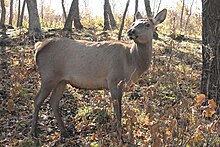Manchurian wapiti
| Manchurian wapiti | |
|---|---|

| |
| Scientific classification | |
| Domain: | Eukaryota |
| Kingdom: | Animalia |
| Phylum: | Chordata |
| Class: | Mammalia |
| Order: | Artiodactyla |
| Family: | Cervidae |
| Genus: | Cervus |
| Species: | |
| Subspecies: | C. c. xanthopygus
|
| Trinomial name | |
| Cervus canadensis xanthopygus (H. Milne-Edwards, 1867)
| |
The Manchurian wapiti (Cervus canadensis xanthopygus) is a subspecies of the wapiti native to East Asia.
Description
The Manchurian wapiti's coat is reddish brown during summer, and brownish gray in winter. It has dark hairs on the neck and dark underparts, followed by a light-colored rump patch. It is smaller than North American elk (Cervus canadensis canadensis) with smaller and stouter antlers.
Male deer are wapiti-like with a neck mane, and as mentioned, relatively small wapiti-like antlers. Female deer are more red deer-like and lack neck manes. This deer is the most red deer-like of the wapiti, being adapted to mixed deciduous forest environments in Manchuria, Yakutia, Northern China and North Korea. Like many red deer, adult deer may have some visible spots in their summer coats.
Cows weigh 140 to 215 kilograms (309 to 474 lb) and bulls weigh 170 to 350 kilograms (370 to 770 lb), and bulls attain measurements of 1.5m in height and 2.4m in length.[1][2]
Range
This deer is found in southeastern Siberia (to the east of Lake Baikal), northeastern Mongolia, Manchuria, North Korea[3] and northeastern China. Similar forms from Alxa, Gansu, Shanxi and southern Mongolia were originally described as a distinct subspecies, the Alashan wapiti (Cervus canadensis alashanicus). However recent genetic research indicates that this deer belongs to the Manchurian subspecies.[4]
References
- ^ Valerius Geist (January 1998). Deer of the World: Their Evolution, Behaviour, and Ecology. Stackpole Books. p. 211. ISBN 978-0-8117-0496-0.
- ^ Manchurian wapiti - Pierre Wildlife (pdf)
- ^ Incheon National University, 2019, 한반도 포유류(척삭동물문: 포유강)의 분류학적 정립과 한국 지형에 맞는 포유류 조사기법 연구 (Studies on the Taxonomic Review and Survey Techniques for Mammals in the Korean Peninsula), p.108 (PDF)
- ^ Mitochondrial DNA phylogeography of red deer (Cervus elaphus), by Christian J. Ludt. In Molecular Phylogenetics and Evolution 31 (2004), p. 1064–1083. Online copy Archived 2008-04-09 at the Wayback Machine
